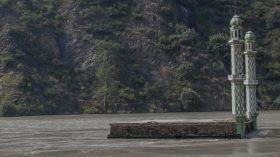Srinagar
The Baglihar dam constructed by India in occupied Kashmir bears testimony to the enormous human costs associated with hydroelectricity projects, a new film reveals.
“The human costs of the Baglihar dam” filmed and directed by journalist, Raqib Hameed Naik, was featured in the UK-based environmental news organization, The Third Pole.
The film extensively talks about how Baghlihar dam in Chenab Valley destroyed homes and livelihood of many families. It shows how, a decade after being displaced by the Baglihar dam, locals are caught in a web of poverty and debt with some experiencing mental health issues as a result of losing everything.
“Dams are wreaking a disaster on the lives of locals in Jammu and Kashmir,” Raqib said. “The human aspect of dams is always missing from the public discourse in this region. This film was made with the objective to highlight those issues,” he added.
Situated at least 65 kilometres downstream of Pul Doda on the river Chenab, the Baglihar dam forced more than 1,400 people to relocate after the water levels rose and submerged everything in its way including roads, houses, and shops.
Pul Doda, once a thriving business centre for dozens of surrounding villages in Jammu region, is now half submerged in the river Chenab. Until 2008 the town in Doda district was home to more than 400 families, mostly small traders, who were relatively prosperous for the region. It is now gone. The construction of Baglihar dam submerged the town. Most families were forcibly displaced and their lives descended into chaos.
“It was like a death-blow,” recalled 37-year-old Dheeraj Sharma, who owned a pharmacy. “It (the dam) took away everything we had earned with our blood and sweat throughout our lives,” he added.
People who had spent their whole lives in the town, seeing it develop from a village to a place full of commercial activity, were suddenly left homeless and without any source of income. A decade after being displaced by the dam, locals are caught in a web of poverty and debt with some experiencing mental health issues as a result of losing everything.
Jebina Khanday, 35, used to live with her parents and three siblings in a five-room house in Pul Doda. Back then, she had a job at the Life Insurance Corporation of India with many plans for her future. But being displaced by the Baglihar dam changed everything for her.
Her father Ghulam Mohammad Khanday, 70, lost his shop.—KMS










